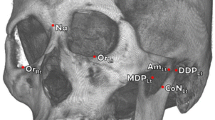Abstract
For patients with TMJ dysfunction, operators often change the condylar position by various methods. The aim of this study is to investigate how much the changes with time of condylar positions are related to the changes of clinical signs.
The subjects were 584 joints of 127 patients with TMJ dysfunction to whom the serial lateral TMJ tomography was performed more than twice.
In the most of cases where the condylar position had moved downward, inter-incisal distance had increased and TMJ noise had ameliorated. Furthermore, in many cases where the condylar position had moved forward, the amelioration of the TMJ pain was observed.
It was considered that those ameliorations occurred because the positional relationship between the condylar head and the articular disk or posterior attachment had been improved.
Similar content being viewed by others
References
Hosoki, H., Takagi, Y., Iwasaki, H., and Uemura, S.: A radiological follow-up study on the patients with temporomandibular joint (TMJ) arthrosis; Relationship between the timing of radiologic examination and the morphological change of the condylar head.J. Jpn. Soc. T.M.J. 2(1): 48–58, 1990
Iwasaki, H.: A cineradiographic study on functional diagnosis of the temporomandibular arthrosis. Dert. Radiol 22: 51–81, 1982
Murakami, S., Hao-Zong WU., Takahashi, A., Nishiyama, H., Fujishita, M. and Fuchihata, H.: An analysis of jaw movement by video-fluorography.J. Jpn. Soc. T.M.J. 4(3): 11–21, 1992
Westesson, P.L.:Double-contrast arthrography and internal derangement of the temporomandibular joint. Suppl 13, 1982
Eckerdal, O. and Lundberg, M.: Temporomandibular joint relations as revealed by conventional radiographic techniques; A comparison with the morphology and tomographic images.Dentmaxillofac. Radiol. 8: 65–70, 1979
Toller, P. A.: Osteoarthrosis of the mandibular condyle.Br. Dent. J. 134: 223–231, 1973
Rasmussen, O. C.: Longitudinal study of transpharyngeal radiography in temporomandibular arthropathy.Scand. J. Dent. Res 88: 257–268, 1980
Takahashi, A. and Fuchihata, H.: A study on reliability of the tomographic image of the temporomandibular joint.Oral Radiol. 5(1): 11–22, 1989
Pullinger, A. G. and Hollender, L.: Variation in condyle-fossa relationship according to different methods of evaluation in tomograms.Oral Surg. 67: 719–727, 1986
Ogura, H.: A diagnostic study on the temporomandibular arthrosis using tomography; Three dimensional measurement of TMJ bony space.Dent. Radiol. 24: 81–99, 1984
Mongini, F.: The importance of radiography in the diagnosis of TMJ dysfunctions; A comparative evaluation of transcranial radiographs and serial tomography.J. Prosthet. Dent. 45: 186–198, 1981
Author information
Authors and Affiliations
Rights and permissions
About this article
Cite this article
Murakami, S., Fujishita, M., Takahashi, A. et al. Longitudinal study of patients with TMJ dysfunction by tomographic examination: Condylar position and clinical sign. Oral Radiol. 9, 41–47 (1993). https://doi.org/10.1007/BF02349102
Received:
Revised:
Accepted:
Issue Date:
DOI: https://doi.org/10.1007/BF02349102




